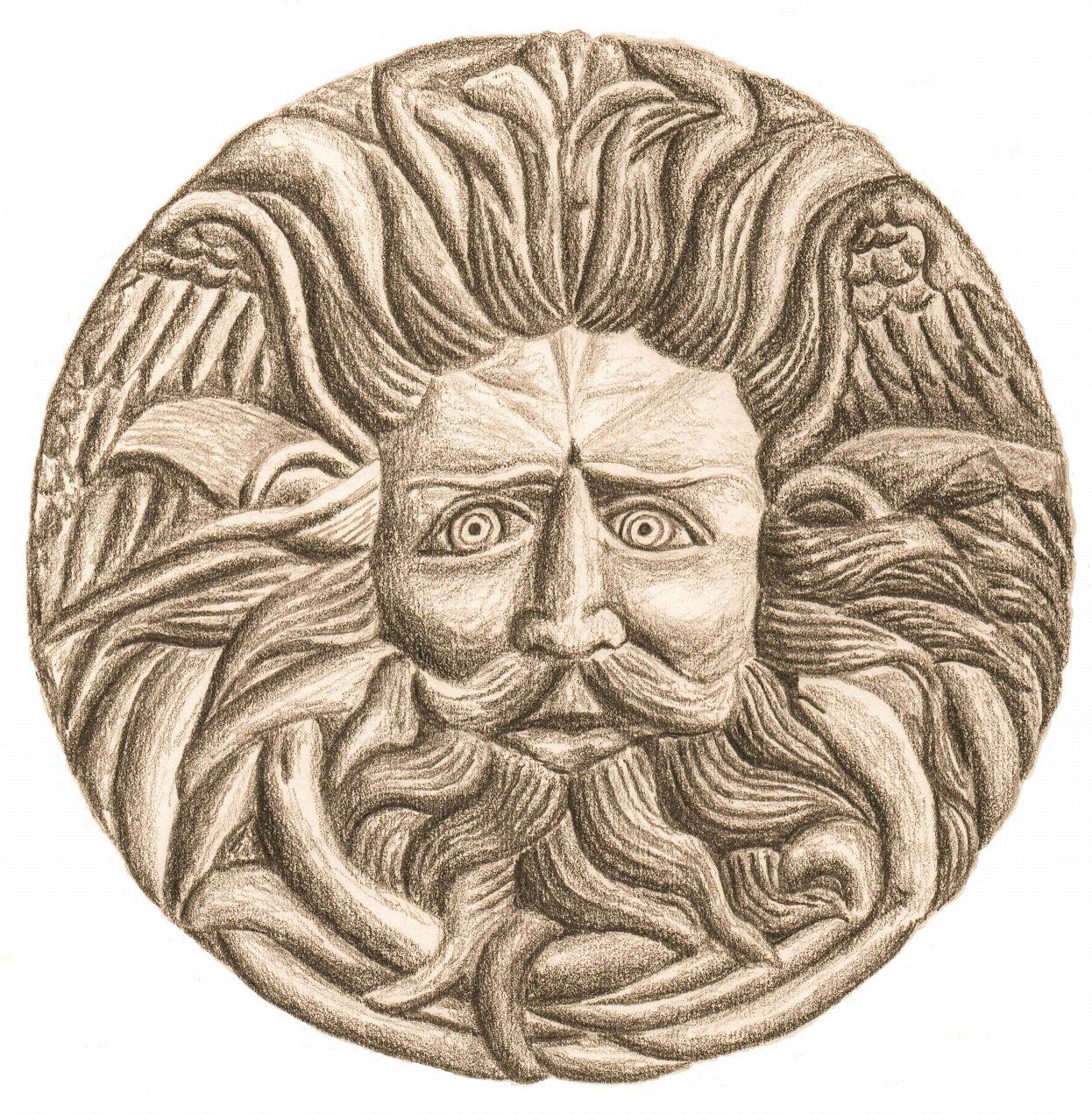Wild Man of the Forest
The Roman-era stone face at the ritual springs at Aquae Sulis (the Waters of Sulis), Bath, England, is of uncertain meaning. The hot spring was sacred even before the Romans built a large complex at the site. Sulis was an important Celtic deity associated with water and healing. The Celts have had a long history of regarding springs as sacred, and there is considerable archaeological evidence of people throwing coins and other sacrificed objects into Aquae Sulis. The tradition of the sacred spring is preserved in the form of today’s wishing well.
Numerous historians have referred to this bas-relief as a male Celtic Medusa, comparing it to the Greek gorgon whose stare could turn people to stone. The Medusa plays an important role in the story of Perseus and Andromeda, and she is well known as having hair full of snakes. The association of the image from Bath with the Medusa is not clearly justified. Two snakes are visible in the lower third of the carving, and there may be more surrounding the face. Even the two feathered wings behind each ear are frequently found with Medusa, seeming to confirm the interpretation.
Romans frequently combined Classical and regional deities, and this may be what this represents. The face from Aquae Sulis also has the appearance of the ruler of the forest, the master of the animals. The idea that different areas had a dominant entity who held sway over creatures of the woods is ancient. It is echoed in the medieval tradition of the wild man and the green man with manes of disheveled hair, living in the forest and acted as its guardian. The antiquity of the motif finds expression in Enkidu, the wild man and companion of Gilgamesh, the hero of ancient Mesopotamia.
This entity transformed into an all-purpose, elf-like trickster, equally at home in the human world as in the forest. The Irish referred to character as pucca, an ancestor of Puck who figures in literature, including Shakespeare’s plays. Related characters give evidence of the wide distribution of this name. For the Welsh, it was bucca, for the Latvians the house sprite was pukis, and for the Swedes, the familiar of a witch was puke. The ancient Greeks called the creature Pan, which became the root for one of the personifications of the devil after conversion. This is why the devil is frequently depicted with goat legs, and indeed, Pan was a noa name, a safe way to refer to the devil in medieval times.
Internationally, there are many variations of creatures linked with nature, some of whom behave in ways that are reminiscent of the owners of nature without fitting the strictest definition. In North America’s Great Basin, Northern Paiute tradition includes the paúngaa’a, which translates as “water baby,” a name that does not match the sinister quality of the creature. This ruler of the water plays an important role in a testimonial legend that tells of a woman who left her infant in a cradleboard by the water while she gathered edible plants. She hears her infant crying, and so she returns and attempts to suckle the baby. When the baby opens its mouth, it reveals huge fangs, and it bites into the breast of the woman. It is, in fact, the paúngaa’a, which has devoured the baby and is now chewing on the mother. The woman must quickly summon a shaman with paúngaa’a power to chant the demon away. The supernatural being responds by retreating back into the water. This legend warns about the dangers of the water and about not being an attentive mother. To achieve this, it calls on the belief in a ruler of the water.
While the female sprite dominates the forest, these examples serve to demonstrate that there were also beliefs involving male rulers of the forest. Medieval literature has many references to wild men, fur-covered custodians of animals and trees. It was a widespread belief throughout Europe that the forest was inhabited either by these wild men or by creatures that were half goat and half man. The latter were good-natured but mischievous with an exaggerated sexual appetite.
This text is an excerpt from my book, which I have used as an introduction - in an evolving form - since I first taught folklore in 1980. It adapts the text that my mentor, Sven S. Liljeblad (1899-2000), used during his career as a professor. The source is as follows: Ronald M. James, Introduction to Folklore: Traditional Studies in Europe and Elsewhere (appearing in its current form in 2017). The image is also by my hand.
.jpg)